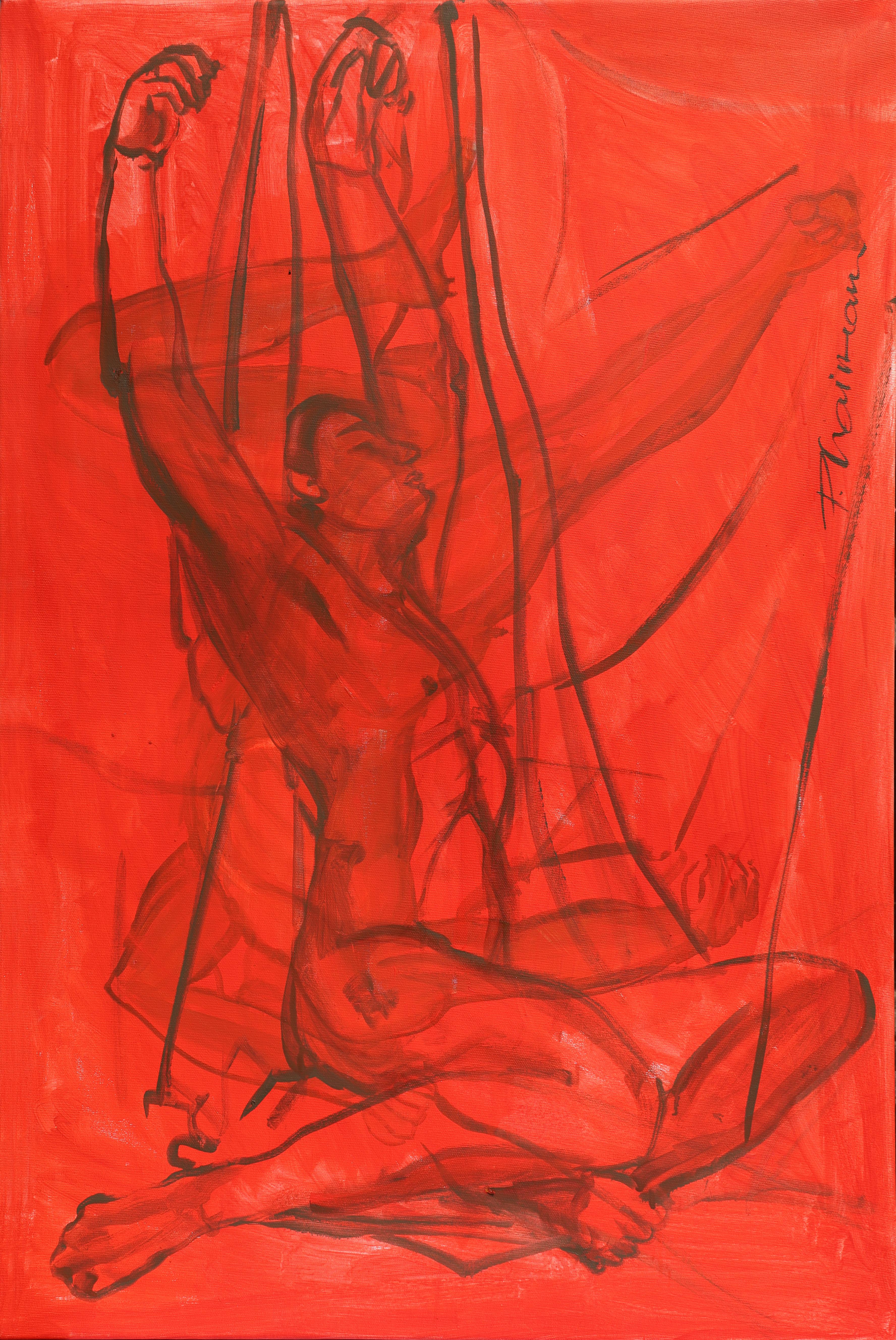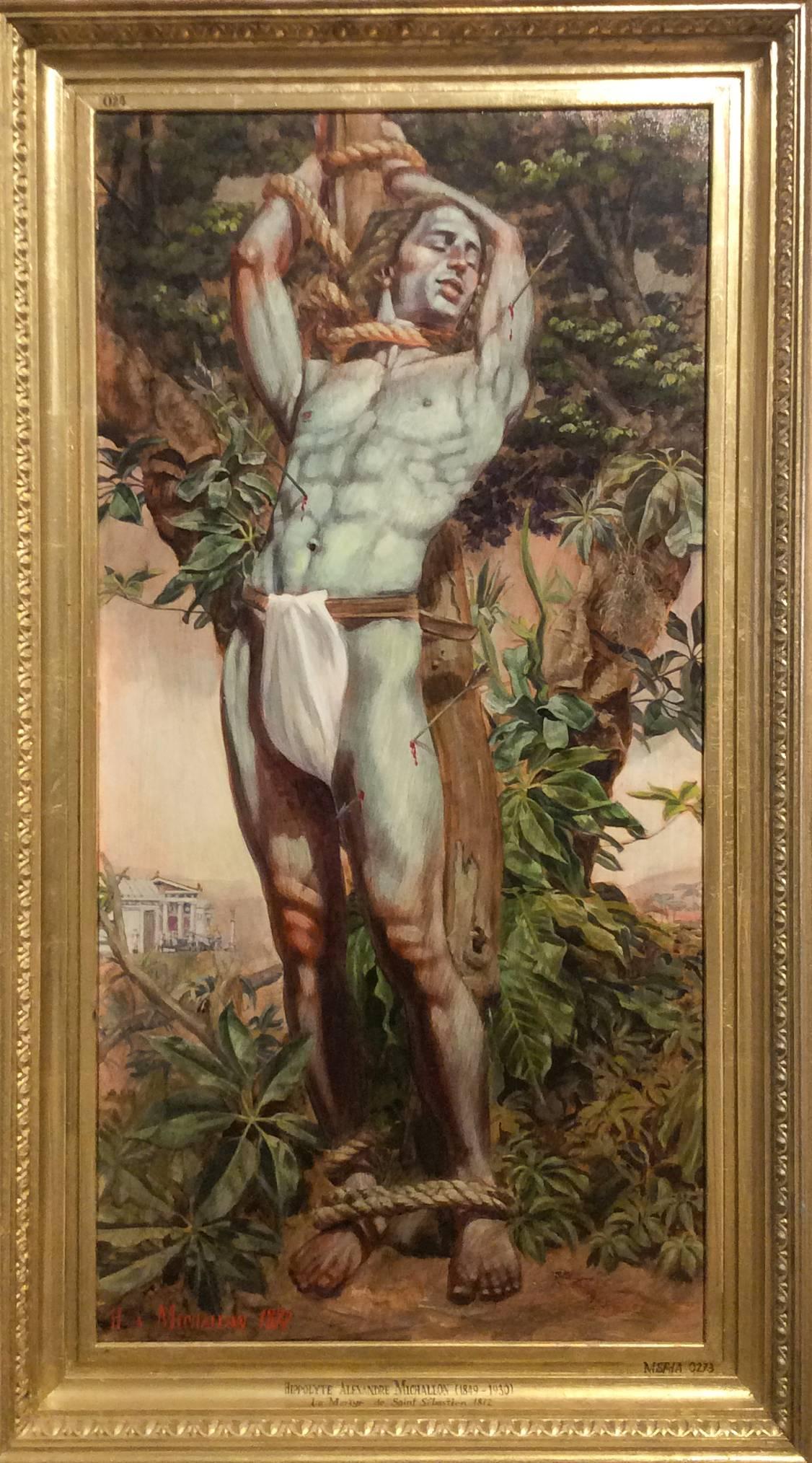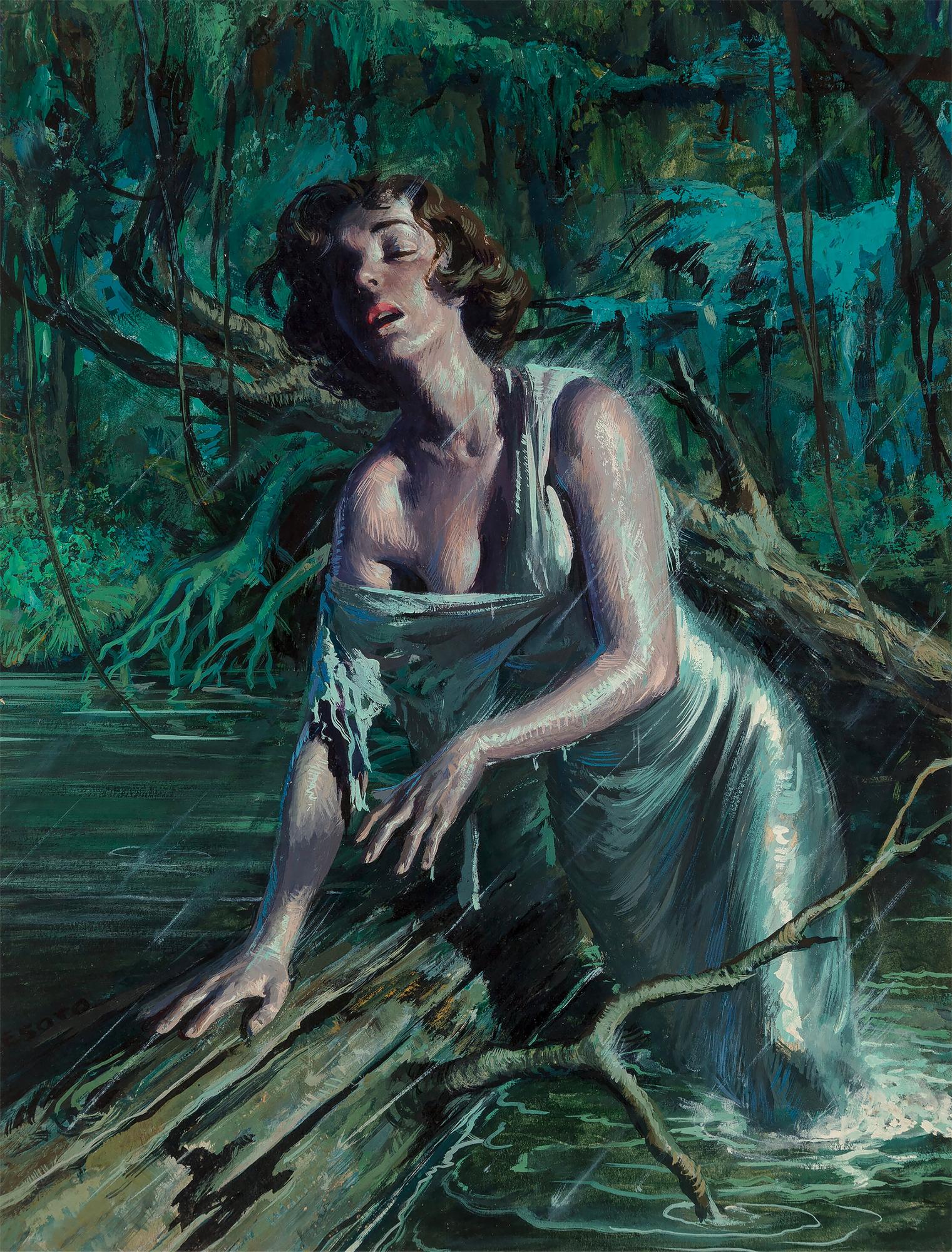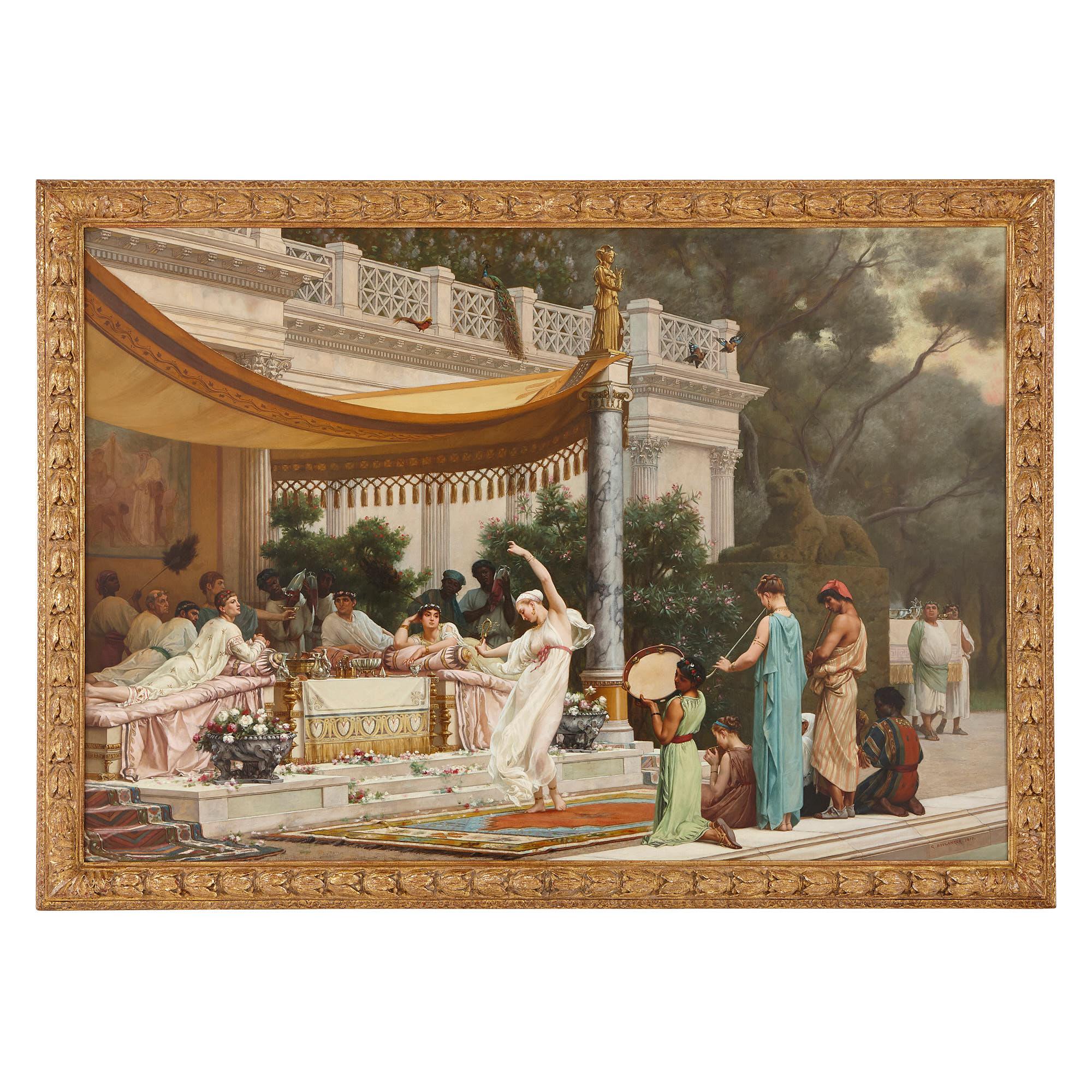Items Similar to The gift of flowers
Video Loading
Want more images or videos?
Request additional images or videos from the seller
1 of 11
Conrad KieselThe gift of flowersc. 1900
c. 1900
About the Item
Conrad Kiesel (1846-1921), The gift of flowers. Oil on wood, 43 x 35 cm, 69 x 61 cm (frame), signed at lower left "Conrad Kiesel pxt [pinxit]", about 1900. In a magnificent gilt stucco frame of the period. With an old London gallery label on the reverse.
- Major retouching by the artist himself to lighten the incarnate. The painting is in very good condition, the frame partially rubbed and bumped.
- The depth of allegory -
At first glance, Conrad Kiesel illustrates Flora, the goddess of blossom and spring, and yet the figure depicted does not fit into the traditional iconography. Flora has neither black hair nor does she wear a laurel wreath. Based on traditional imagery, Conrad Kiesel creates a novel allegory that includes eros, death, and the triumph of art over death alongside the unfolding of life.
The flowers illustrate the blossoming life whose beauty is before our eyes in the young woman. The flowers seem to formally turn towards her, and her antiquing gray-blue robe has a folded structure related to the flowers, so that it in turn seems like a calyx of blossoms from which the youthful beauty emerges. The garment not only allows a view of her upper arm, which animates the imagination of the shoulder and the tracing of the elegant neck line, where the two pink chrysanthemums 'look' at the youthful beauty, the garment is translucent, so that her breast becomes visible in a game of concealment and revelation.
The blossoming life imbued with Eros is contrasted by the black hair and dark eye sockets, allegorically introducing the dimension of death into the motif. But the young woman is also crowned with the laurel wreath of eternal glory, so that the flora becomes Victoria, illustrating that glory overcomes death. At the same time, the laurel wreath is also a symbol of poetry, making the young woman the personification of poetry and inspiration, as well as a muse. Consistent with this aspect of eternity, which refers to art itself, the yellowish background appears like a golden ground, against which the young woman appears like a saint.
Conrad Kiesel was especially sought after as a portraitist. In this painting, in which he did not follow a portrait commission, he had the freedom to follow his own pictorial ideas completely. He created a multi-layered allegory whose mysterious appeal lies in the fact that it cannot be definitively resolved.
The painting is an excerpt and allegorical intensification of his picture 'Die Margareten' in the Manchester Art Gallery, which in variation was also converted into painting by the Königliche Porzellan-Manufaktur (KPM).
While the oriental beauty is hawking the flowers there, the young woman in our picture takes two yellow flowers from the bouquet with an elegant gesture in order to offer them to the one whom her gaze has chosen and whose name her sensually open mouth already seems to pronounce.
The change from oriental beauty to allegory explains the retouching done to lighten the incarnate. This sensitivity to color is also evident in the decision to have the young woman remove two yellow flowers from the otherwise pink bouquet. Combined with the gray-blue of the garment, this creates a subtle, well-balanced tension of color.
About the artist
Conrad Kiesel first studied architecture at the Royal Academy of Architecture in Düsseldorf, but then transferred to the Berlin Academy of Arts to study sculpture with Fritz Schaper. After working as a sculptor for six years, he decided to become a painter, inspired by a trip to Holland. He was first a student of Fritz Paulsen in Berlin, then moved to Düsseldorf to study under Wilhelm Sohn.
"With Wilhelm Sohn he acquired colouristic skills which he quickly developed to the highest virtuosity, namely in the treatment of shiny silk and atlas fabrics".
Adolf Rosenberg
After a stay in Munich, Conrad Kiesel settled in Berlin in 1885 and became a sought-after society and portrait painter in the highest circles. He painted portraits of Wilhelm II and the Empress Augusta. In 1886 he was appointed Royal Professor.
He was awarded the gold medal several times at the exhibitions of the Berlin Academy. His works were regularly exhibited at the Academy exhibitions in Düsseldorf and Vienna and at the Glass Palace in Munich. Internationally, he exhibited at the Royal Academy of Arts and was represented in 1910 at the Paris, and 1911 at the Roman World's Fair.
GERMAN VERSION
Conrad Kiesel (1846-1921), The gift of flowers. Oil on wood, 43 x 35 cm, 69 x 61 cm (frame), signed at lower left "Conrad Kiesel pxt [pinxit]", about 1900. In a magnificent gilt stucco frame of the period. With an old London gallery label on the reverse.
- Major retouching by the artist himself to lighten the incarnate. The painting is in very good condition, the frame partially rubbed and bumped.
- The depth of allegory -
At first glance, Conrad Kiesel illustrates Flora, the goddess of blossom and spring, and yet the figure depicted does not fit into the traditional iconography. Flora has neither black hair nor does she wear a laurel wreath. Based on traditional imagery, Conrad Kiesel creates a novel allegory that includes eros, death, and the triumph of art over death alongside the unfolding of life.
The flowers illustrate the blossoming life whose beauty is before our eyes in the young woman. The flowers seem to formally turn towards her, and her antiquing gray-blue robe has a folded structure related to the flowers, so that it in turn seems like a calyx of blossoms from which the youthful beauty emerges. The garment not only allows a view of her upper arm, which animates the imagination of the shoulder and the tracing of the elegant neck line, where the two pink chrysanthemums 'look' at the youthful beauty, the garment is translucent, so that her breast becomes visible in a game of concealment and revelation.
The blossoming life imbued with Eros is contrasted by the black hair and dark eye sockets, allegorically introducing the dimension of death into the motif. But the young woman is also crowned with the laurel wreath of eternal glory, so that the flora becomes Victoria, illustrating that glory overcomes death. At the same time, the laurel wreath is also a symbol of poetry, making the young woman the personification of poetry and inspiration, as well as a muse. Consistent with this aspect of eternity, which refers to art itself, the yellowish background appears like a golden ground, against which the young woman appears like a saint.
Conrad Kiesel was especially sought after as a portraitist. In this painting, in which he did not follow a portrait commission, he had the freedom to follow his own pictorial ideas completely. He created a multi-layered allegory whose mysterious appeal lies in the fact that it cannot be definitively resolved.
The painting is an excerpt and allegorical intensification of his picture 'Die Margareten' in the Manchester Art Gallery, which in variation was also converted into painting by the Königliche Porzellan-Manufaktur (KPM).
While the oriental beauty is hawking the flowers there, the young woman in our picture takes two yellow flowers from the bouquet with an elegant gesture in order to offer them to the one whom her gaze has chosen and whose name her sensually open mouth already seems to pronounce.
The change from oriental beauty to allegory explains the retouching done to lighten the incarnate. This sensitivity to color is also evident in the decision to have the young woman remove two yellow flowers from the otherwise pink bouquet. Combined with the gray-blue of the garment, this creates a subtle, well-balanced tension of color.
About the artist
Conrad Kiesel first studied architecture at the Royal Academy of Architecture in Düsseldorf, but then transferred to the Berlin Academy of Arts to study sculpture with Fritz Schaper. After working as a sculptor for six years, he decided to become a painter, inspired by a trip to Holland. He was first a student of Fritz Paulsen in Berlin, then moved to Düsseldorf to study under Wilhelm Sohn.
"With Wilhelm Sohn he acquired colouristic skills which he quickly developed to the highest virtuosity, namely in the treatment of shiny silk and atlas fabrics".
Adolf Rosenberg
After a stay in Munich, Conrad Kiesel settled in Berlin in 1885 and became a sought-after society and portrait painter in the highest circles. He painted portraits of Wilhelm II and the Empress Augusta. In 1886 he was appointed Royal Professor.
He was awarded the gold medal several times at the exhibitions of the Berlin Academy. His works were regularly exhibited at the Academy exhibitions in Düsseldorf and Vienna and at the Glass Palace in Munich. Internationally, he exhibited at the Royal Academy of Arts and was represented in 1910 at the Paris, and 1911 at the Roman World's Fair.
- Creator:Conrad Kiesel (1846 - 1921)
- Creation Year:c. 1900
- Dimensions:Height: 27.17 in (69 cm)Width: 24.02 in (61 cm)Depth: 3.15 in (8 cm)
- Medium:
- Movement & Style:
- Period:
- Condition:
- Gallery Location:Berlin, DE
- Reference Number:1stDibs: LU2438213065922

About the Seller
5.0
Vetted Seller
These experienced sellers undergo a comprehensive evaluation by our team of in-house experts.
Established in 2014
1stDibs seller since 2023
7 sales on 1stDibs
Typical response time: 7 hours
- ShippingRetrieving quote...Ships From: Berlin, Germany
- Return PolicyA return for this item may be initiated within 14 days of delivery.
More From This SellerView All
- Small Nude / - Abstract Figurativity -Located in Berlin, DEGustl Stark (1917 Mainz - 2009 ibid.), Small Nude, 1946. Oil on canvas, marouflaged, 54 x 25 cm (picture), 30 x 60 cm (frame), signed "Stark" top left, verso twice signed "Gustav Stark", inscribed by hand as "Small Nude" and dated by hand "1946". With label of the exhibition of the Bundeshaus Bonn from 1956. - Rubbed area in the lower third of the body, at the same level a retouch in the ochre background. I provisional frame. - Abstract Figurativity - About the artwork During the war, Gustl Stark suffered a particularly severe blow for an artist: he lost his right arm. Nevertheless, he continued to devote himself to art, and the painting, created in 1946, immediately after the end of the Nazi reign of terror, testifies to the dawn of a new era. At the same time, the work is a rare example of the artist's early figurative work, as Stark turned entirely to abstract painting as early as 1950. And even this painting is by no means purely figurative; rather, it already illustrates Stark's turn toward abstraction. We see a female nude, but one that remains faceless. This can be read symbolically and in relation to the immediate past epoch, which, in the face of horrors, silences and blinds - literally renders faceless. In this sense, the figure is positioned to 'look back'. But she does not look. While this meaning may resonate and make the painting an important work of the immediate postwar period, Gustl Stark is primarily concerned with something else here, namely art itself. The absence of the face leads to the body becoming something flat. Due to the de-individualization, we do not see a concrete person with his individual features, but a body surface. And indeed, the body is constructed through an extremely planar design. Even the contour lines that form the corporeality have a planar rather than a linear character, especially where they merge into shadow zones of almost the same color. And the surfaces themselves are not modeled. The incarnate parts do not show any plastic gradations; the corporeality is completely withdrawn into the plane, which is also true for the hair. In addition, there is no uniform background against which the figure could appear; rather, the area next to the hair is kept bluish, creating a succession of earth-toned colored areas, which again binds the figure to the surface. Last but not least, the flatness is also forced by the painting technique. Gustl Stark paints directly, a la prima, onto the coarse canvas, whereby the structure of the painting support remains visible in the picture, and in places - around the hair, for example - the canvas itself can be seen. This structural all-over lends the picture a certain flatness. Gustl Stark thus uses the very motif that stands for the corporeality of art par excellence - the female nude - to transform the spatiality of the traditional picture into a flatness characteristic of modern art. And yet, a strong impression of corporeality is created, without being produced by a painterly modeling of the body. The oscillation between flatness and corporeality creates the intense tension of this groundbreaking painting. In Gustl Stark's oeuvre, as a consequence of the abstraction we see here, the figurative is completely stripped away in a further step, which is also a loss when looking at this early key work. About the artist Gustl Stark was the son of a woodcarver and, after an apprenticeship as a decorative painter, attended the State School of Arts and Crafts in Mainz from 1936 to 1937. Although he was severely wounded in the war and lost his right arm, he studied at the Würzburg School of Painting and Drawing from 1943-1944 and then at the Academy of Fine Arts in Nuremberg from 1944-1948. He won a state scholarship at the state art competition in Bad Ischl. Numerous study trips to Sylt, Paris, Switzerland, Austria, Italy, Holland and Belgium followed. Gustl Stark worked in Mainz and was the first artist there to focus on abstract painting. His work quickly gained international recognition, including the Salon Réaliés Nouvelles in Paris. From 1963-1970 he taught at the State University Institute for Art and Work Education in Mainz and from 1970-1975 at the Johannes Gutenberg University. Gustl Stark became particularly famous for his color embossed prints, for which he invented his own technique. Gustl Stark received numerous awards for his work. He received the Art Prize for Painting of the City of Mainz in 1962, the State Prize of Rhineland-Palatinate in 1984, and the Gutenberg Bust of the City of Mainz in 1987. Selected Bibliography Hans Vollmer (Hrsg.): Allgemeines Lexikon der bildenden Künstler des XX. Jahrhunderts, Vierter Band, Leipzig 1958, S. 344. Hans H...Category
1940s Realist Nude Paintings
MaterialsCanvas
- Mary Magdalene - Faith transforms inner into outer beauty and conquers death -By Balthasar DennerLocated in Berlin, DEBalthasar Denner (1685 Hamburg - 1749 Rostock). Mary Magdalene. Oil on copper, 37 × 32 cm (visible size), 45 x 40 cm (frame), signed and indistinctly dated "Denner 17(...)" at centre...Category
1720s Old Masters Figurative Paintings
MaterialsCopper
- Landscape with Trees by a Lake - Eternal summer silence over an abysmal lake -Located in Berlin, DEAndreas Thomas Juuel (1816 Copenhagen - 1868 Copenhagen). Summer landscape with tall deciduous trees by a lake. Oil on canvas, 54,5 x 42 cm (visible size), 71 x 58 cm (frame), signed...Category
1850s Realist Landscape Paintings
MaterialsOil
- Autumn Landscape in Sunlight - Indian Summer -Located in Berlin, DEFrederick Vezin (1859 Torresdale Philadelphia - 1933 Düsseldorf), Autumn Landscape in the Sunlight, oil on canvas, mounted on cardboard, 32 x 41 cm (inside measurement), 44 x 51 cm (...Category
Early 1900s Impressionist Landscape Paintings
MaterialsOil, Cardboard
- Children with geese in the light of a summer eveningLocated in Berlin, DEMagda Kremer (*1942 Hengelo), Children with geese in the light of a summer evening. Oil on canvas, 40 x 50 cm (inside measurement), 52 x 62 cm (frame), signed by hand with "M.[agda] ...Category
Mid-20th Century Realist Figurative Paintings
MaterialsOil
- Half-length portrait of an elderly bearded man - Melancholy of a prophet -Located in Berlin, DEFriedrich August Seitz (1902 Staffort - 1944 Belgrade). Half-length portrait of an elderly man with a beard. Oil on canvas, 42 x 34 cm (visible seize), 58 x 50 cm (frame), signed and...Category
1920s Expressionist Figurative Paintings
MaterialsOil
You May Also Like
- Composition with Two Male Nudes - painting Paula Craioveanu oil on canvasBy Paula CraioveanuLocated in Forest Hills, NY"Composition with Two Male Nudes", oil and silver leaf on canvas, 35.5x23.5in / 90x60cm Part of my Male Nude series. Shipped as it is, stretched, directly from the artist's studio.Category
2010s Academic Figurative Paintings
MaterialsCanvas, Oil
- Le Martyr de Saint Sebastian (Academic Figurative Oil Painting in Gold Frame)By Mark BeardLocated in Hudson, NYAcademic style figurative oil painting on canvas 48 x 24 inches unframed 58 x 32 x 3 inches in gold leaf wood frame This vertical, contemporary figurative painting of Le Martyr de Saint Sebastian was made by Mark Beard under his fictitious artistic persona, Hippolyte-Alexandre Michallon. Painted in a modern Academic style, Beard paints this Christian saint with dramatic detail and emotional gravity. The scene is a common artistic depiction of Sebastian who according to traditional belief, was killed during the Roman emperor Diocletian's persecution of the Christians. Here the artist depicts a nearly nude Saint Sebastian standing stoically while tied to a rustic brown post. A lush green forested terrain decorates the background while a white neo-classical building sits in the distance, which is perhaps the tomb where Saint Sebastian's remains were laid to rest. Saint Sebastian's pale blue-grey, stone-like stone tone is characteristic of Mark Beard's work who often portrays muscular young men similarly to Greek statues. The vertical Academic style figurative oil painting is complimented with a vintage style gold leaf wood frame. The painting is signed 'H. A. Michallon 1872' in red oil paint in the lower right corner. The gold frame is also signed and inscribed with black oil paint in several places (please see images). Mark Beard is a contemporary artist who made this work under the pseudonym Hippolyte A. Michallon who painted during the late 1800's so slight wear (see images) is intentionally staged to align with the factitious artist's purposed history. About the artist: Mark Beard is perhaps the most literal example of an artist pulled in so many different directions that he chose to “invent” six different personae in which to channel his overflowing energy and need for expression. Each painting style is radically different from the next, so it remains entirely believable that the work could stem from six completely different people of different time periods and different schools of thought. With a background in set design, Beard has always been one who could conjure total magic with anything available. Mark Beard has exhibited with Carrie Haddad Gallery for nearly twenty years and there has never been a dull moment. Mark Beard, born in 1956 in Salt Lake city, now lives in New York City. His works are in museum collections worldwide, including the Metropolitan Museum of Art, New York City; the Museum of Modern Art, New York City; the Whitney Museum of American Art, New York City; the Boston Museum of Fine Arts; and the Harvard, Yale, and Princeton University Art Museums; among many others. We would not be the least bit surprised to see new ‘personas’ emerge in the coming years. About: Hippolyte - Alexandre Michallon, 1849 -1930 The long and peripatetic artistic career of Hippolyte-Alexandre Michallon began in a conventional fashion. The only son of prosperous bourgeois parents in Tours, he first studied drawing with his mother, an accomplished amateur painter of insects. His father, an undertaker who appreciated his son's talent and supported his ambition to become a painter, sent him to Paris at age sixteen to enroll in the studio of Francois-Edouard Picot (1786-1868), an eminent history painter and professor at the Ecole des Beaux-Arts, with whom he studied for three years, until Picot's death. Under his aging teacher's guidance and tutelage, Michallon entered the preliminary stages of the Prix de Rome contest at the Ecole three times, winning an Honorable Mention in 1869 for his composition entitled The Solider of the Marathon. For the next twenty years Michallon regualarly exhibited paintings on historical and biblical themes at the Paris Salon, as well as commissioned portraits. By his own account, the most ambitious work of Michallon's career was a thirty-foot canvas depicting Noah's Ark, which he exhibited in the Salon in 1875. Michallon began painting atmospheric but zoologically correct images of exotic animals in the wild. These achieved a certain popularity among French and foreign collectors alike, providing Michallon with financial security for the first time in his career. Michallon moved to England in 1893. His outstanding technical skills easily earned him a position on the faculty of the Slade School of Art in 1900. The craze for animal paintings proved short-lived. He continued to teach at Slade for the next two decades, but his classes gradually dwindled in size as the academic approach and methods he espoused went from outmoded to downright unpopular. Finally in 1922, finding himself reduced to a single pupil, the talented young American Bruce Sargeant, he retired from Slade, persuading Sargeant to leave with him and undergo private instruction at home. Several years later he retired to a cottage at St. Ives, Cornwall, where he lived quietly until his death in 1930, forgotten by all but a few former students, among them Edith Thayer Cromwell...Category
Early 2000s Academic Figurative Paintings
MaterialsCanvas, Oil
- Sexy Woman in a Swamp Storm - Pulp Magazine, Hispanic Artist, Mid CenturyBy Rafael DeSotoLocated in Miami, FLRafael Maria de Soto y Hernandez was born February 18, 1904 in Aguadilla, Puerto Rico. It's high drama in the swamp. Woman in the Swamp is a masterfully executed example of Pulp Art and showcases Rafael DeSoto's full command of academic painting. DeSoto did pulp covers up until the industry's demise in the 1950s for such magazines as Adventure, Argosy, Black Mask, Captain Zero, Crack Detective, Fantastic Novels, 15-Story Detective, Fifteen Western Tales, New Detective, Smashing Detective, and Walt Coburn's Western Magazine. He also painted many covers and interior story illustrations for men's adventure magazines, such as Action For Men, Adventure, Battle Cry, For Men Only...Category
1950s Academic Figurative Paintings
MaterialsBoard, Oil
- 'A Summer Repast at the House of Lucullus', large oil painting by BoulangerBy Gustave Clarence Rodolphe BoulangerLocated in London, GBThis beautiful painting was created in 1877 by the well-known French painter, Gustave Clarence Rodolphe Boulanger. Boulanger often produced work which combined the classical and Orie...Category
Late 19th Century Academic Figurative Paintings
MaterialsCanvas, Oil
- Classical Naturalistic Style Italian Allegory StudyLocated in Houston, TXClassical style allegorical painting with puti and monarchy type figures floating within the clouds. The canvas is framed in a decorative gold frame. Dimensions Without Frame: H 43.5...Category
20th Century Academic Figurative Paintings
MaterialsOil
- Nude WomanLocated in Wilton Manors, FLBeautiful female nude in profile. European, ca. 1920-30. Oil on canvas, 31.5 x 35.75 inches; 35.5 x 39.75 inches framed. Sign indistinctly upper right. A few areas of paint loss (v...Category
Early 20th Century Academic Nude Paintings
MaterialsOil




